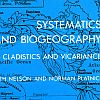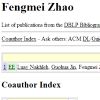| |
  
Mark Clement,
David Posada and
Keith A. Crandall. TCS: a computer program to estimate gene genealogies. In MOLE, Vol. 9:1657-1659, 2000.
Keywords: from sequences, parsimony, phylogenetic network, phylogeny, Program TCS, reconstruction, software, statistical parsimony.
Note: http://darwin.uvigo.es/download/papers/08.tcs00.pdf.
Toggle abstract
[No abstract available]
|
|
| |
|
| |

Jotun Hein. A heuristic method to reconstruct the history of sequences subject to recombination. In JME, Vol. 36(4):396-405, 1993.
Keywords: explicit network, from sequences, heuristic, parsimony, phylogenetic network, phylogeny, Program RecPars, recombination, recombination detection, software.
Note: http://dx.doi.org/10.1007/BF00182187.
|
|
| |
|
| |
   
Cam Thach Nguyen,
Nguyen Bao Nguyen,
Wing-Kin Sung and
Louxin Zhang. Reconstructing Recombination Network from Sequence Data: The Small Parsimony Problem. In TCBB, Vol. 4(3):394-402, 2007.
Keywords: explicit network, from sequences, labeling, NP complete, parsimony, phylogenetic network, phylogeny.
Note: http://www.cs.washington.edu/homes/ncthach/Papers/TCBB2007.pdf.
|
|
| |
 
David Posada and
Keith A. Crandall. Intraspecific gene genealogies: trees grafting into networks. In TEE, Vol. 16(1):37-45, 2001.
Keywords: likelihood, median network, netting, parsimony, phylogenetic network, phylogeny, Program Arlequin, Program SplitsTree, Program T REX, Program TCS, pyramid, reticulogram, split decomposition, statistical parsimony, survey.
Note: http://darwin.uvigo.es/download/papers/09.networks01.pdf.
|
|
| |
|
| |
  
Alan R. Templeton,
Keith A. Crandall and
Charles F. Sing. A Cladistic Analysis of Phenotypic Associations With Haplotypes Inferred From Restriction Endonuclease Mapping and DNA Sequence Data. III. Cladogram Estimation. In GEN, Vol. 132:619-633, 2000.
Keywords: from sequences, parsimony, phylogenetic network, phylogeny, Program TCS, recombination, reconstruction, statistical parsimony.
Note: http://www.genetics.org/cgi/content/abstract/132/2/619.
|
|
| |
 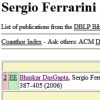 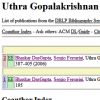 
Bhaskar DasGupta,
Sergio Ferrarini,
Uthra Gopalakrishnan and
Nisha Raj Paryani. Inapproximability results for the lateral gene transfer problem. In JCO, Vol. 11(4):387-405, 2006.
Keywords: approximation, from rooted trees, from species tree, inapproximability, lateral gene transfer, parsimony, phylogenetic network, phylogeny.
Note: http://www.cs.uic.edu/~dasgupta/resume/publ/papers/t-scenario-3-reviewed-3.pdf.
|
|
| |
  
Insa Cassens,
Patrick Mardulyn and
Michel C. Milinkovitch. Evaluating Intraspecific Network Construction Methods Using Simulated Sequence Data: Do Existing Algorithms Outperform the Global Maximum Parsimony Approach? In Systematic Biology, Vol. 54(3):363-372, 2005.
Keywords: abstract network, evaluation, from unrooted trees, haplotype network, parsimony, phylogenetic network, phylogeny, Program Arlequin, Program CombineTrees, Program Network, Program TCS, reconstruction, software.
Note: http://www.lanevol.org/LANE/publications_files/Cassens_etal_SystBio_2005.pdf.
|
|
| |
  
Steven M. Woolley,
David Posada and
Keith A. Crandall. A Comparison of Phylogenetic Network Methods Using Computer Simulation. In PLoS ONE, Vol. 3(4):e1913, 2008.
Keywords: abstract network, distance between networks, evaluation, median network, MedianJoining, minimum spanning network, NeighborNet, parsimony, phylogenetic network, phylogeny, Program Arlequin, Program CombineTrees, Program Network, Program SHRUB, Program SplitsTree, Program TCS, split decomposition.
Note: http://dx.doi.org/10.1371/journal.pone.0001913.
Toggle abstract
"Background: We present a series of simulation studies that explore the relative performance of several phylogenetic network approaches (statistical parsimony, split decomposition, union of maximum parsimony trees, neighbor-net, simulated history recombination upper bound, median-joining, reduced median joining and minimum spanning network) compared to standard tree approaches (neighbor-joining and maximum parsimony) in the presence and absence of recombination. Principal Findings: In the absence of recombination, all methods recovered the correct topology and branch lengths nearly all of the time when the subtitution rate was low, except for minimum spanning networks, which did considerably worse. At a higher substitution rate, maximum parsimony and union of maximum parsimony trees were the most accurate. With recombination, the ability to infer the correct topology was halved for all methods and no method could accurately estimate branch lengths. Conclusions: Our results highlight the need for more accurate phylogenetic network methods and the importance of detecting and accounting for recombination in phylogenetic studies. Furthermore, we provide useful information for choosing a network algorithm and a framework in which to evaluate improvements to existing methods and novel algorithms developed in the future. © 2008 Woolley et al."
|
|
| |
|
| |
 
Ran Libeskind-Hadas and
Michael A. Charleston. On the Computational Complexity of the Reticulate Cophylogeny Reconstruction Problem. In JCB, Vol. 16(1):105-117, 2009.
Keywords: cophylogeny, heuristic, NP complete, parsimony, phylogenetic network, reconstruction.
Note: http://dx.doi.org/10.1089/cmb.2008.0084.
Toggle abstract
"The cophylogeny reconstruction problem is that of finding minimal cost explanations of differences between evolutionary histories of ecologically linked groups of biological organisms. We present a proof that shows that the general problem of reconciling evolutionary histories is NP-complete and provide a sharp boundary where this intractability begins. We also show that a related problem, that of finding Pareto optimal solutions, is NP-hard. As a byproduct of our results, we give a framework by which meta-heuristics can be applied to find good solutions to this problem. © Mary Ann Liebert, Inc. 2009."
|
|
| |
|
| |
|
| |
|
| |
|
| |

Hans-Jürgen Bandelt and
Arne Dür. Translating DNA data tables into quasi-median networks for parsimony analysis and error detection. In MPE, Vol. 42(1):256-271, 2007.
Keywords: abstract network, from sequences, parsimony, phylogenetic network, phylogeny, quasi-median network, reconstruction.
Note: http://dx.doi.org/10.1016/j.ympev.2006.07.013.
Toggle abstract
"Every DNA data table can be turned into a quasi-median network that faithfully represents the data. We show that for (weighted) condensed data tables the associated network harbors all most parsimonious reconstructions for any tree that connects the sampled haplotypes. Structural features of this network can be computed directly from the data table. The key principle repeatedly used is that the quasi-median network is uniquely determined by the sub-tables for pairs of characters. The translation of a table into a network enhances the understanding of the properties of the data in regard to homoplasy and potential artifacts. The total number of nodes of such a network measures the complexity of the data. In particular, networks that display the results of filter analyses by which hotspot mutations are removed help to detect data idiosyncrasies and thus pinpoint sequencing problems. A pertinent example drawn from human mtDNA illustrates these points. © 2006 Elsevier Inc. All rights reserved."
|
|
| |
  
Hyun Jung Park,
Guohua Jin and
Luay Nakhleh. Bootstrap-based Support of HGT Inferred by Maximum Parsimony. In BMCEB, Vol. 10:131, 2010.
Keywords: bootstrap, explicit network, from sequences, lateral gene transfer, parsimony, phylogenetic network, phylogeny, Program Nepal, reconstruction.
Note: http://dx.doi.org/10.1186/1471-2148-10-131.
Toggle abstract
"Background. Maximum parsimony is one of the most commonly used criteria for reconstructing phylogenetic trees. Recently, Nakhleh and co-workers extended this criterion to enable reconstruction of phylogenetic networks, and demonstrated its application to detecting reticulate evolutionary relationships. However, one of the major problems with this extension has been that it favors more complex evolutionary relationships over simpler ones, thus having the potential for overestimating the amount of reticulation in the data. An ad hoc solution to this problem that has been used entails inspecting the improvement in the parsimony length as more reticulation events are added to the model, and stopping when the improvement is below a certain threshold. Results. In this paper, we address this problem in a more systematic way, by proposing a nonparametric bootstrap-based measure of support of inferred reticulation events, and using it to determine the number of those events, as well as their placements. A number of samples is generated from the given sequence alignment, and reticulation events are inferred based on each sample. Finally, the support of each reticulation event is quantified based on the inferences made over all samples. Conclusions. We have implemented our method in the NEPAL software tool (available publicly at http://bioinfo.cs.rice.edu/), and studied its performance on both biological and simulated data sets. While our studies show very promising results, they also highlight issues that are inherently challenging when applying the maximum parsimony criterion to detect reticulate evolution. © 2010 Park et al; licensee BioMed Central Ltd."
|
|
| |
 
Lawrence A. David and
Eric J. Alm. Rapid evolutionary innovation during an Archaean genetic expansion. In Nature, Vol. 469:93-96, 2011.
Keywords: duplication, dynamic programming, from multilabeled tree, from rooted trees, from species tree, parsimony, phylogenetic network, phylogeny, Program Angst.
Note: http://dx.doi.org/10.1038/nature09649, Program Angst described here.
|
|
| |
 
Lavanya Kannan and
Ward C Wheeler. Maximum Parsimony on Phylogenetic Networks. In ALMOB, Vol. 7:9, 2012.
Keywords: dynamic programming, explicit network, from sequences, heuristic, parsimony, phylogenetic network, phylogeny.
Note: http://dx.doi.org/10.1186/1748-7188-7-9.
Toggle abstract
"Background: Phylogenetic networks are generalizations of phylogenetic trees, that are used to model evolutionary events in various contexts. Several different methods and criteria have been introduced for reconstructing phylogenetic trees. Maximum Parsimony is a character-based approach that infers a phylogenetic tree by minimizing the total number of evolutionary steps required to explain a given set of data assigned on the leaves. Exact solutions for optimizing parsimony scores on phylogenetic trees have been introduced in the past.Results: In this paper, we define the parsimony score on networks as the sum of the substitution costs along all the edges of the network; and show that certain well-known algorithms that calculate the optimum parsimony score on trees, such as Sankoff and Fitch algorithms extend naturally for networks, barring conflicting assignments at the reticulate vertices. We provide heuristics for finding the optimum parsimony scores on networks. Our algorithms can be applied for any cost matrix that may contain unequal substitution costs of transforming between different characters along different edges of the network. We analyzed this for experimental data on 10 leaves or fewer with at most 2 reticulations and found that for almost all networks, the bounds returned by the heuristics matched with the exhaustively determined optimum parsimony scores.Conclusion: The parsimony score we define here does not directly reflect the cost of the best tree in the network that displays the evolution of the character. However, when searching for the most parsimonious network that describes a collection of characters, it becomes necessary to add additional cost considerations to prefer simpler structures, such as trees over networks. The parsimony score on a network that we describe here takes into account the substitution costs along the additional edges incident on each reticulate vertex, in addition to the substitution costs along the other edges which are common to all the branching patterns introduced by the reticulate vertices. Thus the score contains an in-built cost for the number of reticulate vertices in the network, and would provide a criterion that is comparable among all networks. Although the problem of finding the parsimony score on the network is believed to be computationally hard to solve, heuristics such as the ones described here would be beneficial in our efforts to find a most parsimonious network. © 2012 Kannan and Wheeler; licensee BioMed Central Ltd."
|
|
| |
   
Mareike Fischer,
Leo van Iersel,
Steven Kelk and
Celine Scornavacca. On Computing The Maximum Parsimony Score Of A Phylogenetic Network. In SIDMA, Vol. 29(1):559-585, 2015.
Keywords: APX hard, cluster containment, explicit network, FPT, from network, from sequences, integer linear programming, level k phylogenetic network, NP complete, parsimony, phylogenetic network, phylogeny, polynomial, Program MPNet, reconstruction, software.
Note: http://arxiv.org/abs/1302.2430.
|
|
| |
  
Yun Yu,
R. Matthew Barnett and
Luay Nakhleh. Parsimonious Inference of Hybridization in the Presence of Incomplete Lineage Sorting. In Systematic Biology, Vol. 62(5):738-751, 2013.
Keywords: from network, from rooted trees, hybridization, lineage sorting, parsimony, phylogenetic network, phylogeny, Program PhyloNet, reconstruction.
Toggle abstract
"Hybridization plays an important evolutionary role in several groups of organisms. A phylogenetic approach to detect hybridization entails sequencing multiple loci across the genomes of a group of species of interest, reconstructing their gene trees, and taking their differences as indicators of hybridization. However, methods that follow this approach mostly ignore population effects, such as incomplete lineage sorting (ILS). Given that hybridization occurs between closely related organisms, ILS may very well be at play and, hence, must be accounted for in the analysis framework. To address this issue, we present a parsimony criterion for reconciling gene trees within the branches of a phylogenetic network, and a local search heuristic for inferring phylogenetic networks from collections of gene-tree topologies under this criterion. This framework enables phylogenetic analyses while accounting for both hybridization and ILS. Further, we propose two techniques for incorporating information about uncertainty in gene-tree estimates. Our simulation studies demonstrate the good performance of our framework in terms of identifying the location of hybridization events, as well as estimating the proportions of genes that underwent hybridization. Also, our framework shows good performance in terms of efficiency on handling large data sets in our experiments. Further, in analysing a yeast data set, we demonstrate issues that arise when analysing real data sets. Although a probabilistic approach was recently introduced for this problem, and although parsimonious reconciliations have accuracy issues under certain settings, our parsimony framework provides a much more computationally efficient technique for this type of analysis. Our framework now allows for genome-wide scans for hybridization, while also accounting for ILS. [Phylogenetic networks; hybridization; incomplete lineage sorting; coalescent; multi-labeled trees.] © 2013 The Author(s). All rights reserved."
|
|
| |
 
Lavanya Kannan and
Ward C Wheeler. Exactly Computing the Parsimony Scores on Phylogenetic Networks Using Dynamic Programming. In JCB, Vol. 21(4):303-319, 2014.
Keywords: explicit network, exponential algorithm, from network, from sequences, parsimony, phylogenetic network, phylogeny, reconstruction.
Toggle abstract
"Scoring a given phylogenetic network is the first step that is required in searching for the best evolutionary framework for a given dataset. Using the principle of maximum parsimony, we can score phylogenetic networks based on the minimum number of state changes across a subset of edges of the network for each character that are required for a given set of characters to realize the input states at the leaves of the networks. Two such subsets of edges of networks are interesting in light of studying evolutionary histories of datasets: (i) the set of all edges of the network, and (ii) the set of all edges of a spanning tree that minimizes the score. The problems of finding the parsimony scores under these two criteria define slightly different mathematical problems that are both NP-hard. In this article, we show that both problems, with scores generalized to adding substitution costs between states on the endpoints of the edges, can be solved exactly using dynamic programming. We show that our algorithms require O(mpk) storage at each vertex (per character), where k is the number of states the character can take, p is the number of reticulate vertices in the network, m = k for the problem with edge set (i), and m = 2 for the problem with edge set (ii). This establishes an O(nmpk2) algorithm for both the problems (n is the number of leaves in the network), which are extensions of Sankoff's algorithm for finding the parsimony scores for phylogenetic trees. We will discuss improvements in the complexities and show that for phylogenetic networks whose underlying undirected graphs have disjoint cycles, the storage at each vertex can be reduced to O(mk), thus making the algorithm polynomial for this class of networks. We will present some properties of the two approaches and guidance on choosing between the criteria, as well as traverse through the network space using either of the definitions. We show that our methodology provides an effective means to study a wide variety of datasets. © Copyright 2014, Mary Ann Liebert, Inc. 2014."
|
|
| |
|
| |
|
| |
  
Celine Scornavacca,
Joan Carles Pons and
Gabriel Cardona. Fast algorithm for the reconciliation of gene trees and LGT networks. In JTB, Vol. 418:129-137, 2017.
Keywords: duplication, explicit network, from network, from rooted trees, lateral gene transfer, LGT network, loss, parsimony, phylogenetic network, phylogeny, polynomial, reconstruction.
|
|
| |
|
| |
  
Leo van Iersel,
Mark Jones and
Celine Scornavacca. Improved maximum parsimony models for phylogenetic networks. In SB, Vol. 67(3):518-542, 2018.
Keywords: explicit network, FPT, from sequences, NP complete, parsimony, phylogenetic network, phylogeny, reconstruction, weakly displaying.
Note: https://leovaniersel.files.wordpress.com/2017/12/improved_parsimony_networks.pdf.
|
|
| |
  
Edwin Jacox,
Cédric Chauve,
Gergely J. Szöllösi,
Yann Ponty and
Celine Scornavacca. EcceTERA: comprehensive gene tree-species tree reconciliation using parsimony. In BIO, Vol. 32(13):2056-2058, 2016.
Keywords: duplication, explicit network, from rooted trees, from species tree, lateral gene transfer, loss, parsimony, phylogenetic network, phylogeny, polynomial, Program ecceTERA.
Note: https://doi.org/10.1093/bioinformatics/btw105.
|
|
| |
  
Dingqiao Wen,
Yun Yu,
Jiafan Zhu and
Luay Nakhleh. Inferring Phylogenetic Networks Using PhyloNet. In SB, Vol. 67(4):735-740, 2018.
Keywords: bayesian, likelihood, parsimony, phylogenetic network, phylogeny, Program PhyloNet, reconstruction, software.
|
|
|
|
| |
|
| |
   
Guohua Jin,
Luay Nakhleh,
Sagi Snir and
Tamir Tuller. A New Linear-time Heuristic Algorithm for Computing the Parsimony Score of Phylogenetic Networks: Theoretical Bounds and Empirical Performance. In ISBRA07, Vol. 4463:61-72 of LNCS, springer, 2007.
Keywords: approximation, heuristic, parsimony, phylogenetic network, phylogeny, Program Nepal.
Note: http://www.cs.rice.edu/~nakhleh/Papers/isbra07.pdf.
|
|
| |
|
| |
|
| |
|
| |
   
Bhaskar DasGupta,
Sergio Ferrarini,
Uthra Gopalakrishnan and
Nisha Raj Paryani. Inapproximability results for the lateral gene transfer problem. In Proceedings of the Ninth Italian Conference on Theoretical Computer Science (ICTCS'05), Pages 182-195, springer, 2005.
Keywords: approximation, from rooted trees, from species tree, inapproximability, lateral gene transfer, parsimony, phylogenetic network, phylogeny.
Note: http://www.cs.uic.edu/~dasgupta/resume/publ/papers/ictcs-final.pdf.
|
|
| |
  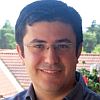
Mike Hallett,
Jens Lagergren and
Ali Tofigh. Simultaneous Identification of Duplications and Lateral Transfers. In RECOMB04, Pages 347-356, 2004.
Keywords: duplication, explicit network, FPT, from rooted trees, from species tree, lateral gene transfer, loss, NP complete, parsimony, phylogenetic network, phylogeny, polynomial, reconstruction.
Note: http://www.nada.kth.se/~jensl/p164-hallett.pdf.
|
|
| |
 
Ernst Althaus and
Rouven Naujoks. Reconstructing Phylogenetic Networks with One Recombination. In Proceedings of the seventh International Workshop on Experimental Algorithms (WEA'08), Vol. 5038:275-288 of LNCS, springer, 2008.
Keywords: enumeration, explicit network, exponential algorithm, from sequences, generation, parsimony, phylogenetic network, phylogeny, reconstruction, unicyclic network.
Note: http://dx.doi.org/10.1007/978-3-540-68552-4_21.
Toggle abstract
"In this paper we propose a new method for reconstructing phylogenetic networks under the assumption that recombination events have occurred rarely. For a fixed number of recombinations, we give a generalization of the maximum parsimony criterion. Furthermore, we describe an exact algorithm for one recombination event and show that in this case our method is not only able to identify the recombined sequence but also to reliably reconstruct the complete evolutionary history. © 2008 Springer-Verlag Berlin Heidelberg."
|
|
| |

Pawel Górecki. Reconciliation problems for duplication, loss and horizontal gene transfer. In RECOMB04, Pages 316-325, 2004.
Keywords: duplication, explicit network, from rooted trees, from species tree, lateral gene transfer, loss, NP complete, parsimony, phylogenetic network, phylogeny, polynomial, reconstruction.
Note: http://ai.stanford.edu/~serafim/CS374_2004/Papers/Gorecki_Reconciliation.pdf.
|
|
| |

Pawel Górecki. Single step reconciliation algorithm for duplication, loss and horizontal gene transfer model. In ECCB03, 2003.
Keywords: duplication, explicit network, from rooted trees, from species tree, lateral gene transfer, NP complete, parsimony, phylogenetic network, phylogeny, polynomial, reconstruction.
Note: http://www.inra.fr/eccb2003/posters/pdf/short/S_gorecki.ps.
|
|
| |
|
| |
|
|
|
 - forked on GitHub.
- forked on GitHub.


















































